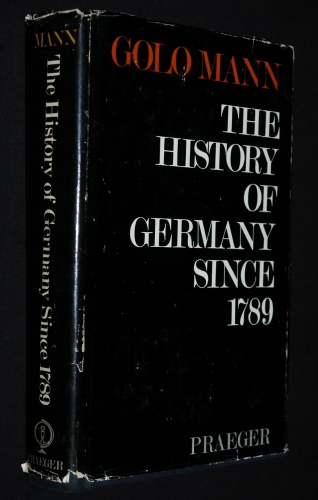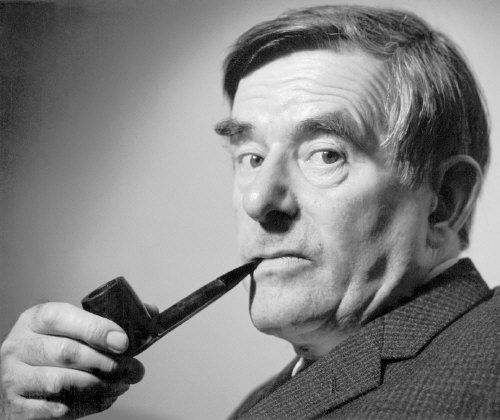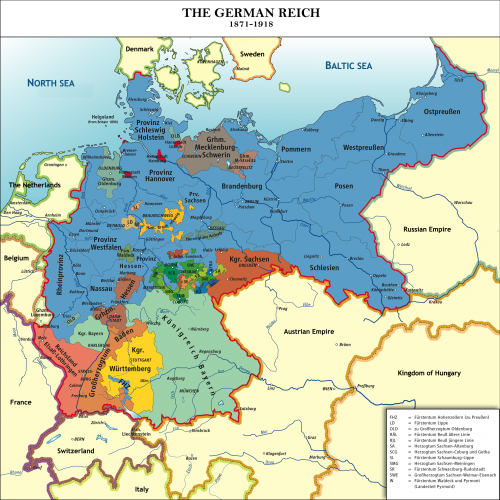mercredi, 25 novembre 2020
Golo Mann on the Conservative Revolution in Germany

Golo Mann on the Conservative Revolution in Germany
Fergus Cullen
Ex: https://ferguscullen.blogspot.com
Golo Mann’s discussion of the Conservative Revolution in The History of Germany since 1789 (Penguin, 1985) begins with Oswald Spengler, whose positions (anti-Hohenzollern, socialist, anti-progressive, militarist…), mark the beginning of a novel movement, “overthrowing conventional ways of thinking in politics.” For Mann, the C.R. is “confused,” a “strange combination of words,” and yet somehow, perfectly simple: Conservative Revolutionists “rejected not certain aspects of the Republic but the whole of it, and the whole present; they […] wanted to ask completely new questions and offer completely new ideas” (p. 620).

Their temperament was unsuited to parliamentarism or the new international order, though suited to poetry and the formation of groupuscules (pp. 620–1). Mann provides a perfect, lapidary, aphoristic précis of “the conservative-revolutionary attitude” (Mohler): “They wanted a new Reich without party squabbles, a Reich of the young and of masculine virtues, a great, proud gathering around a camp-fire instead of the capital Berlin. They expected much more from the modern state than it can give them at the best of times” (p. 621). Here we have their anti-parliamentarism, the spirit of the Freikorps (“the Ideas of 1914”), the bündisch spirit. And of course “the best of times,” measured by “quality of life,” which strikes them as the coming of the Last Man: see Leo Strauss on “German Nihilism” Interpretation, 26.3 (spring, 1999), specifically p. 360.
I believe that a thorough investigation, from the perspective either of the histoire des sensibilités or des mentalités, or of the history of ideas, can reveal, and indeed all but has revealed, a conservative-revolutionary essence that is anything but “confused”; but Mann specifies the nature of this “confusion,” at the level of sensibilité, through the case of Ernst Jünger: “We cannot know, and he probably did not know himself, what he wanted, what he feared with compassionate sensitivity and what he only pretended to want. The doubts which tortured his fine mind he hid behind the mask of the inflexible writer-officer who gives his readers orders” (p. 621).
Mann’s is a peculiar though understandable position: Klemens von Klemperer misrepresents him as sceptical of C.R.’s validity as historical category (Klemperer, Central European History, 30.3 [1997], p. 458); but it is rather that, for Mann, the sensibilités and mentalités of a clearly definable current strike him as confused: “one’s head reels in dealing with it” (p. 622). Mann does not quite succeed in making a case for confusion, so to speak. He asserts “an unusual confusion of aims”; the reader is to understand that their “hyper-modern view” and classical “absence of emotion,” “hardness and brittleness” are at odds with their romantic, neo-mediaevalist idealisation of the Hohenstaufen, etc. (ibid.). I repeat my formula in return: conservative revolution is an abstraction and radicalisation of conservative principles necessitated by the completion of (“early”) modernity with industrialisation and democratisation, and the arrival of (“proto-”) postmodernity. (See my previous notes on Stefan Breuer and Panagiotis Kondylis.)

Mann says that for the Conservative Revolutionists, “ideas, of which there was an abundance in Germany, were less important than character, activity and life” (ibid.). Two elements. First, as Kondylis describes, with the intensification of modernity, ideas, ideology, discourse, reason, etc., in the contemporary understanding of these terms, become the more and more the medium of politics. This is perhaps a characteristic of “the best of times”: a shift away from force and towards at least the appearance of reason. Second, in revolting against these “best” of times, Conservative Revolutionists at least make an appearance of disdaining ideas, ideology, discourse, reason, etc.; but again, as Kondylis describes, this was a “purely polemical abhorrence”; “only theoretically could the idealised description of a ‘healthy’ and ‘organic’ society be made which is not created by abstract theories, nor does it need them.”
Finally, Mann describes succinctly and helpfully how party politicians like von Papen tried to “woo” these troublesome young anti-parliamentarians, and how, with economic crisis and the failure of the party system, alliance between Conservative Revolutionists and the “average Conservative” was “much talked about”; but how ultimately “[i]t was absorbed and ruined by the real, anything but ‘conservative,’ revolution which now began in earnest” (p. 623)—National Socialism, that is. Mann does not elaborate on this “absorption”; but two camps emerge in the literature. For the professed Conservative Revolutionists Rauschning and Mohler, C.R. and N.S. are quite distinct, even if there were moments of collaboration, and ultimately defection. For Leo Strauss, whose own relationship to the movement is ambiguous, both C.R. and N.S. are expressions of an underlying current of “German nihilism.”
Postscript. On Nietzsche: “Balanced essays were replaced by aphorisms, thrown out like orders” (p. 397). Compare this to his characterisation of Jünger (“orders”). Mann does not deal with Nietzsche as proto-Conservative Revolutionary. He dispenses with C.R. as Nietzscheanism with a disparaging tacit allusion to Baeumler (p. 402). But his choice of the same word in these instances implies the continuity. Part of that continuity is Nietzsche’s and the latter right-Nietzscheans’ rejection of discourse: a meta-discourse about, and sceptical of the use of, discourse.
00:39 Publié dans Livre, Livre, Révolution conservatrice | Lien permanent | Commentaires (0) | Tags : golo mann, révolution conservatrice, allemagne, république de weimar, années 20, années30 |  |
|  del.icio.us |
del.icio.us |  |
|  Digg |
Digg | ![]() Facebook
Facebook



Les commentaires sont fermés.